Dangerous Sea Creatures
Belize is home of many dangerous Creatures. Smaller animals actually
present more of a threat to humans than large
animals. To compensate for their size, nature has given many small
animals weapons such as fangs and stingers to defend themselves. These
are the animals you are more likely to meet as you unwittingly
move into their habitat, or they slip into your environment unnoticed.
There are several species of venomous fish and invertebrates, all of
which live in salt water. All of these are capable of injecting
poisonous venom through spines located in their fins, tentacles, or
bites. Their venoms cause intense pain and are potentially fatal. If
injured by one of these fish or invertebrates, treat the injury as for
snakebite.
Auger
Shells
The Auger Shells or
Terebra, are similar to cone shells but much thinner and longer.
They
poison in the same way as cone shells, but their venom is not as
poisonouIn some cones, the venom is powerful enough to be lethal to
collectors who are not careful in handling the mollusc. World-wide,
there are about 300 species
|
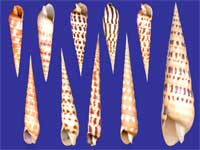
Terebridae
|
|
Cone
shells
These cone-shaped
shells have smooth, colorful mottling and
long, narrow openings in the base of the shell. They live under rocks,
in crevices and coral reefs, and along rocky shores and protected bays
in tropical areas. All have tiny teeth that are similar to hypodermic
needles. Avoid any shell
shaped like an ice cream cone.
They can inject an
extremely poisonous
venom that acts very
swiftly, causing acute pain, swelling, paralysis, blindness, and
possible death within hours. Avoid handling all cone shells. Three
species that are known killers are the Geographic Cone (Conus
geo- graphus)
the Textile Cone (Conus textile), and the Tulip Cone (Conus tulipus)
though around twenty cones are known to be dangerous to humans.
|
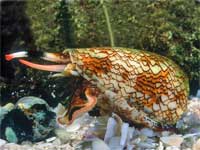
Conidae
Size, max 6" or 15 cm
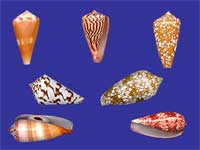 Conidae Collection
Conidae Collection
|
Fire Coral
Fire corals have a
bright yellow-green and brown skeletal covering and
are widely distributed in tropical and subtropical waters. They appear
in small brush-like growths on rocks and coral. Divers often mistake
fire coral for seaweed, and accidental contact is common.
Fire corals are colonial marine organisms that look rather like real
coral. However they are technically not corals; they are actually more
closely related to jellyfish and other stinging anemones.
|
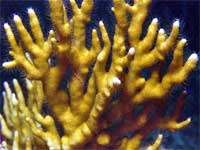
Net fire coral
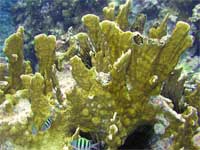
Plate fire coral
|
The very
small nematocysts on fire corals
contain tentacles that protrude from numerous surface pores (similar to
Jelly Fish stings).
In addition, fire corals have a sharp, calcified external skeleton that
can scrape the skin.
|
Portugese
man on war
Although it
resembles a jellyfish, the Portuguese man-of-war is
actually a colony of sea animals. Mainly found in tropical regions, the
Gulf stream current can carry it as far as Europe. It is also found as
far south as Australia.
The Portuguese man-of-war resembles a
large pink or purple balloon floating on the sea. The floating portion
of the man-of-war may be
as small as 15 centimeters, but the tentacles can reach 12 meters in
length. The huge tentacles
are actually colonies of stinging cells. These tentacles inflict a
painful and incapacitating sting, but
the sting is rarely fatal.
|
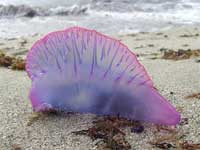
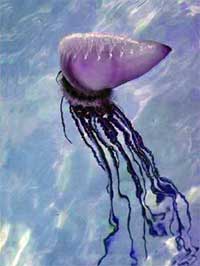
|
Scorpion
Fish or Zebra Fish
Scorpion
fish live
mainly in the reefs. They vary from 30 to 90 centimeters long, are
usually reddish
in coloration, and have long wavy fins and spines. They inflict an
intensely painful sting. Rockfish, also
referred to as scorpion fish in the tropics, are found
most often in the sand or near rocks, even where the water is shallow.
It has stingers on its head and fins.
|
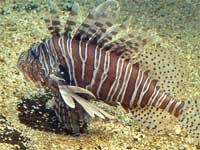
Scorpaena plumiere
|
Stone
Fish
Stonefish are found
in the tropical waters of the Pacific and Indian
oceans. Averaging about 30 centimeters in length, their subdued colors
and lumpy shape provide them with exceptional camoflauge. When stepped
on, the fins in the dorsal spine inflict an extremely painful and
sometimes fatal wound. The Stonefish is the most venomous fish in the
world.
|
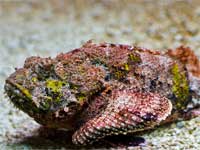
Synanceja
verrucosa
|
Surgeonfish
The Surgeonfish
or Tang is average 20 to 25 centimeters in length, with a deep
body, small mouth, and bright coloration. Named for extremely sharp and
movable spines located
on each side of their tail that are thought to resemble a
surgeonâs
scalpel, that cause extremely painful wounds.
|
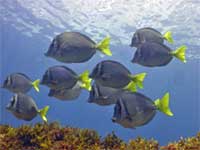
Acanthuridae
|
Toadfish
Toadfish are
between 17.5 and 25 centimeters long and have
a dull color and large mouths. Males make the nests and guard them
after the female lays the eggs.
The
male attracts the female by "singing", that is by releasing air by
contracting muscles on their swim bladder. The sound has been called a
'hum' or 'whistle'. They often hide in rock crevices, among the bottom
vegetation, or even bury themselves in the sand and may
be easily stepped on. They have very sharp, extremely poisonous spines
on the dorsal fin (back).
|
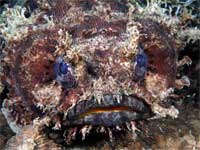
Batrachoididae
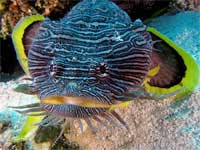
Batrachoididae
|
Jellyfish
Jellyfish-related deaths are rare, but the sting they
inflict is extremely painful. Most known deaths from
jellyfish are attributed to the man-of-war. Other jellyfish can inflict
very painful stings as well. Avoid the long tentacles of any jellyfish,
even those washed up on the beach and apparently dead.
Stingrays
Stingrays (Dasyatidae species) are a real hazard in shallow
waters, especially tropical waters. The type of bottom appears to be
irrelevant. There is a great variance between species, but all have a
sharp spike in their tail that may be venomous and can cause extremely
painful wounds if stepped on. All rays have a typical shape that
resembles a kite. You find them along the coasts of the Americas,
Africa, and Australasia.
|
 |
|

















